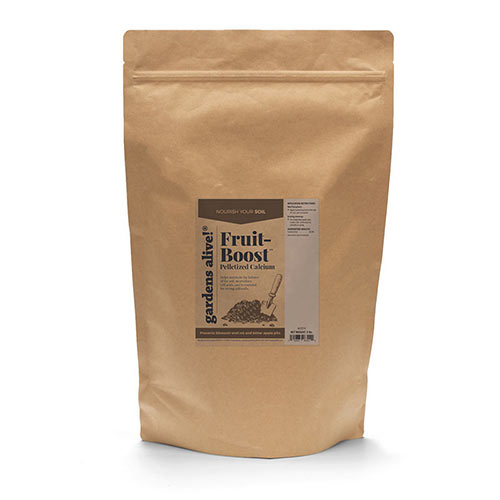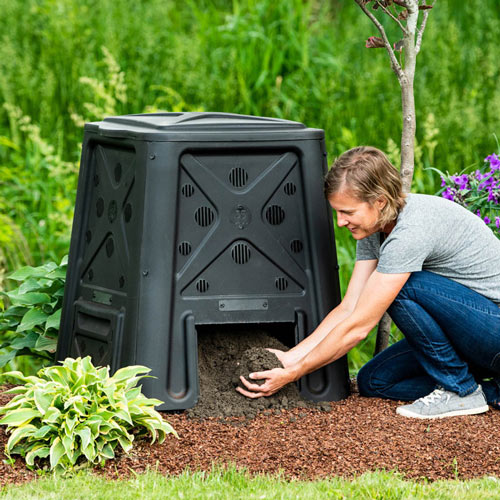A Triple: Tomato Rot! Compost! Wood Chips!
Plus, a special appearance by cuke-free cucumbers
-
Helpful Products from Gardens Alive!
-
 Fruit-Boost™ Pelletized Calcium Carbonate
Fruit-Boost™ Pelletized Calcium Carbonate -
 Munchie 65-Gallon Compost Bin
Munchie 65-Gallon Compost Bin
Q. Helen in Edmond, Oklahoma writes: "My first tomatoes have blossom end rot. My research says the plants need calcium, even though I used new potting soil. The plants themselves are thriving and I only water when the soil is dry six to eight inches down. I used tomato blossom spray since the temps are reaching 90 here in Oklahoma. I have looked at your website and can't find your past Questions of the Week A to Z archives."
A. The archive of over 500 frequently asked questions is still there, but now you search by topic instead of A to Z. And our website seems to have changed recently; the link you click on to reach all those articles now just says "searchable archive". I'll see if we can make that wording a little clearer. But clear or obtuse, it's all at You Bet Your Garden.org!
Blossom end rot: I thought I was boring everyone with my endless repetition of the advice to save up all your eggshells and place the dried crushed shells of a dozen eggs in the planting hole at the time of tomato installation to prevent the heartbreak of blossom end rot; when the 'blossom end' of your tomatoes turns black and rots out just as the tomatoes are ripening. Maybe I should write it into the credits.
Anyway, blossom end rot is caused by a deficiency of calcium (which potting soils don't supply, old or new). At this point in the growing season, you'll have to make the calcium more quickly available, so place the dried eggshells in a blender with water, whiz it all up and then pour this calcium-rich liquid into the soil at the base of your plants. If you ain't got no eggshells, whiz up (in water) a dozen calcium carbonate tablets, a dozen Tums® or a half-cup of an organic plant food specifically designed for tomatoes, like Gardens Alive's Tomatoes Alive! or Espoma's Tomato Tone.
Temps over 90 do have the power to fry the flowers on tomato plants. Not sure what your spray is supposed to do, but afternoon shade as provided by a beach umbrella should help.
Q. Mike in Berwyn, PA writes: "I live on a half-acre lot with many ash, poplar, and maple trees. Every fall I collect and compost the leaves in a 10 x 10-foot space that's four feet deep. But I don't have the ability to shred that many leaves and so they are whole. I just started adding fruit and vegetable scraps from the kitchen and I was wondering if coffee grounds would be ok?"
A. Ai-Yi-Yi-Yi! As I have said more times than Scrooge McDuck has dollars, coffee grounds are the best addition to an outdoor bin of SHREDDED leaves. Kitchen waste is problematic in an open bin as it attracts mice, rats and racoons. Kitchen waste should be composted (always with a greater amount of SHREDDED leaves) only in a sealed bin or, even better, in a worm bin.
And you do have the ability to shred those leaves. Buy an electric leaf blower with a reverse setting and a collection bag, shred some of your leaves every day and you'll have finished compost years earlier.
Q. Shane in Bellbrook, Ohio (near Dayton) writes: "I had a load of arborist wood chips delivered for free from a local tree service; thanks for the tip! I haven't used them before (haven't really used anything other than shredded leaves), but I'm using them now to mulch native perennials, including joe pye weed, bee balm and black-eyed Susan. How much room around the base of those plants should be wood-chip free, or is it safe to cover the base with the chips?"
A. Even though they're not drenched in poisonous dyes, arborist wood chips are still wood, so they should never be mixed into the soil; only used as a one- to two-inch layer on top of the soil. And it is never safe to actually touch the trunk of a tree or the stalk of a plant with any kind of mulch, especially wood. Always leave six inches open all around.
Q. I'd say, "come back Shane!" but I don't have to as there is a follow-up question. Shane writes: "I also have a few cucumber plants that are growing like crazy. I'm getting a lot of flowers, but am not seeing the number of fruits that I'd like."
A. Well, until you mentioned the flowers, I thought you might have overfertilized with nitrogen, like the classic rookie mistake of inhibiting flowering by using horse and poultry manures on the wrong plants, specifically fruiting plants like cucumbers, tomatoes, peppers, squash, etc. But plants that flower without producing fruit are generally the victims of stress, especially early in the season. Cucumbers and summer squash (like zucchini) are notorious for this.
Look carefully at the flowers. Blossoms with a little bulge behind them are female. Flowers with no bulge are male. Try using a small artist's brush to transfer pollen from one flower to another to try and coax things along. And make sure your watering regimen is deep but infrequent.
-
Helpful Products from Gardens Alive!
-
 Fruit-Boost™ Pelletized Calcium Carbonate
Fruit-Boost™ Pelletized Calcium Carbonate -
 Munchie 65-Gallon Compost Bin
Munchie 65-Gallon Compost Bin







 Gardens Alive! & Supplies
Gardens Alive! & Supplies




